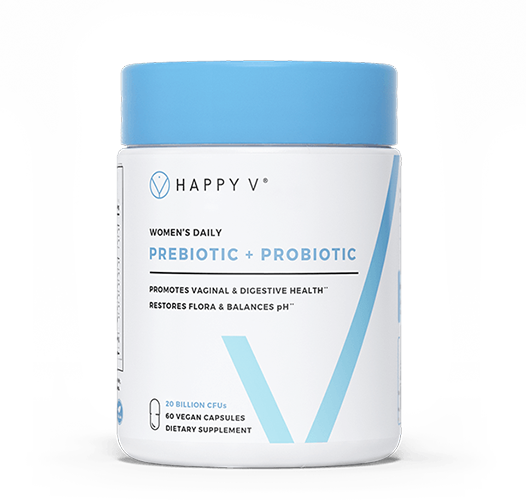- Almost every woman will experience a vaginal yeast infection at least once in their life.
- The most common symptoms of yeast infections include itchiness and thick, cottage cheese-like discharge.
- While yeast infections do not directly cause bleeding, they can cause irritation that can lead to bleeding.
- Any vaginal bleeding that is excessive or persistent should be investigated by a doctor.
- If you suspect you have a yeast infection, seek treatment with antifungals. Once treatment is complete, look to strategies like practicing good hygiene and taking daily probiotics to prevent yeast infections from coming back.

If you have a vagina, you are probably familiar with what a yeast infection is and what it feels like. In fact, the Mayo Clinic estimates that nearly 3 in 4 women will experience a yeast infection at least once in their lifetime, though for some women, this figure is much (and sometimes MUCH) higher.
But what if you notice unexplained vaginal bleeding in conjunction with a yeast infection? Is this normal, or is it cause for concern? That’s what we’re talking about today. Because while symptoms like itching and cottage chees-like discharge are to be expected with yeast infections, bleeding is a less common symptom. Let’s talk about what can cause this and when to see a doctor.
Understanding Yeast Infections

Before we can understand why bleeding sometimes occurs with yeast infections, we have to understand what a yeast infection is.
Vaginal yeast infections go by many names. You may sometimes hear them referred to as candidiasis or vulvovaginal candidiasis. But essentially, all these names describe the same thing: an overgrowth of Candida fungus within the vagina, primarily Candida albicans.
The most common symptoms of a yeast infection include:
- Itching, burning, and irritation of the vaginal area
- Thick, white, odorless vaginal discharge that often resembles cottage cheese
- Pain or discomfort during urination or sex
But there are less common symptoms associated with yeast infections, too, including:
- Redness and swelling of the vulva
- Soreness and rash on the surrounding skin
- Discomfort or pain in the general pelvic region
The symptoms you experience and the severity of your symptoms can vary from infection to infection. Symptoms can range from mild to severe and last just a few days or go on for several weeks if left untreated. That’s why, for both your comfort and your overall health, you should always see a doctor if you ever suspect a vaginal infection. As you’ll see in just a bit, the treatment for vaginal yeast infections is simple and can prevent complications from happening.
Can Yeast Infections Cause Bleeding?

So we just listed the symptoms of a vaginal yeast infection, but we didn’t mention bleeding. So can a vaginal yeast infection ever cause bleeding? Yes and no.
Yeast infections do not cause bleeding on their own, but the symptoms of a yeast infection can lead to bleeding. Take itchiness, for example. If a yeast infection is making you itchy, you might be scratching. And if you are scratching your genital area excessively, this can lead to minor tears that can result in bleeding.
Also, if you are having sex with a yeast infection, especially if you also have an underlying condition like vaginal dryness, the friction can lead to irritation and minor tearing in the vaginal tissue that can result in bleeding.
Other Causes of Bleeding

Don’t think your bleeding is due to excessive scratching or irritation via sex? There are some other reasons you could be experiencing vaginal bleeding outside of your period that have nothing to do with a yeast infection. These include:
- Postcoital bleeding, or bleeding after sexual intercourse
- Intermenstrual bleeding, or bleeding between periods
- Menorrhagia, or heavy or prolonged menstrual bleeding
While none of these are considered an immediate medical emergency, they should not be ignored, either. If you are ever experiencing excessive or persistent bleeding outside of your period, you should call your healthcare provider to make an appointment. They will help you investigate the issue further.
Also, call your healthcare provider if you ever experience vaginal bleeding in conjunction with symptoms like fever, severe pain, or foul-smelling discharge, as this could be a sign of a sexually transmitted infection.
Treating a Yeast Infection: Can it go away on its own?

What should you do if you feel like your vaginal bleeding is due to symptoms of a yeast infection? Seek treatment!
Yeast infections are treated with antifungal medications that are typically available over the counter without a prescription. However, you should still see your doctor before running to the pharmacy. The symptoms of a yeast infection can mimic those of BV, but both require a different treatment to resolve, so you want to confirm your diagnosis. Also, if the yeast infection is severe enough to be causing bleeding, your doctor may want to prescribe you a more powerful antifungal.
The most common antifungal agents are clotrimazole or miconazole, and they are available in many forms, including topical creams and vaginal suppositories. Which form you take is often a matter of personal preference, but your doctor may have some suggestions based on your health history and specific infection.
The worst thing you can do if you are experiencing yeast infection symptoms is to ignore them and hope they go away. While some mild yeast infections can clear on their own, more often than not, you will need to seek treatment to alleviate symptoms like vaginal bleeding and prevent further complications from developing.
Distinguishing between Yeast Infections and Common Conditions

Like we said, the symptoms of yeast infections overlap with symptoms of other common vaginal infections, like BV and UTIs. However, there are some key differences, too.
For example, both yeast infections and BV involve unusual vaginal discharge, but the discharge associated with BV is often thin, gray-ish, and foul or “fishy” smelling, while the discharge associated with yeast infections is often thick, cottage cheese-like, and odorless.
When it comes to UTIs, both yeast infections and UTIs can lead to discomfort while urinating, but with UTIs, the discomfort is often greater, even downright painful, and also accompanied by the frequent urge to urinate, even after you just went.
But again, vaginal infections are not something you want to self-diagnose and self-medicate. Confirm any diagnosis with a doctor before starting any kind of treatment.
When to Seek Medical Attention

Like we said earlier, if you are ever experiencing excessive or prolonged bleeding outside of your period or menstrual blood that’s an unusual color, that’s a sign to call your doctor.
Also, if you ever suspect you have a yeast infection or other vaginal infection while pregnant, call your OB-GYN or other healthcare provider right away. And if you are experiencing recurrent yeast infection, meaning they happen again and again despite antifungal treatment, call your doctor so they can help you get to the root cause and find relief once and for all.
Prevention and Management of Yeast Infections

While most women experience at least one yeast infection in their lives, there are things you can do to prevent yeast infections from becoming a recurrent issue. These include:
- Practicing good hygiene. This includes using condoms, wearing breathable cotton underwear, and wiping from front to back after using the bathroom1.
- Avoiding irritants. The two most common vaginal irritants include scented soaps and douches. Both contain chemicals that can disrupt your vaginal flora and leave you more prone to vaginal infection.
- Maintaining a diet rich in probiotics. Probiotics help fight off bad bacteria and fungi and keep the vagina functioning like it should. They can be found naturally in foods like yogurt, tempeh, miso, and kombucha, but you can also get them through a daily probiotic supplement.
- Managing underlying conditions. If you have diabetes or hormonal imbalances, these can weaken your immune system or disrupt your vaginal flora in ways that make you more prone to vaginal infections. By properly managing these conditions, you will mitigate these risks.
Understanding Happy V’s Vaginal Health Supplement

We briefly mentioned probiotics as a way you can prevent yeast infections and the uncomfortable symptoms that come along with them, but we want to double-click on that point and elaborate on it a bit further. Because while probiotics get talked about a lot when it comes to gut health, they can also help improve your vaginal health, too.
Probiotics are essentially healthy bacteria. When these healthy bacteria populate in your vagina, they help to maintain your vaginal pH and kill bad microbes like Candida albicans before they can cause infection2. Happy V’s Prebiotic + Probiotic is doctor-formulated to contain probiotic strains that have been clinically proven to restore your vaginal microbiome. It also includes other ingredients like Vitamin C and garlic extract that have immune-boosting and antimicrobial properties to maintain vaginal wellness and fight not only yeast infections but BV and UTIs as well.
- Vaginal Yeast Infection: An overgrowth of Candida fungus within the vagina, primarily caused by Candida albicans, leading to symptoms like itching, burning, and thick, white discharge.
- Candidiasis: Another term for a yeast infection, characterized by an overgrowth of Candida fungus.
- Vulvovaginal Candidiasis: Another name for a yeast infection, indicating an overgrowth of Candida fungus in the vaginal and vulvar areas.
- Antifungal Medications: Medications used to treat fungal infections like yeast infections, including clotrimazole or miconazole available in topical creams or suppositories.
- Postcoital Bleeding: Bleeding that occurs after sexual intercourse, which could be due to various reasons including infections or cervical issues.
- Intermenstrual Bleeding: Bleeding that occurs between menstrual periods, often attributed to hormonal changes or underlying health conditions.
- Menorrhagia: Excessive or prolonged menstrual bleeding, sometimes caused by hormonal imbalances or uterine conditions.
- Vaginal Flora: The collection of microorganisms that live in the vagina, including beneficial bacteria like Lactobacillus that help maintain vaginal health.
- Probiotics: Healthy bacteria that promote gut and vaginal health by maintaining a balanced microbiome and inhibiting the growth of harmful bacteria or fungi.
- Vaginal Microbiome: The ecosystem of microorganisms present in the vagina that contribute to its health and functioning.
- Happy V’s Prebiotic + Probiotic: A supplement formulated with probiotic strains and other ingredients to support vaginal health and prevent infections like yeast infections, BV, and UTIs.
- Yeast infection (vaginal). Mayo Clinic. January 11, 2023. Accessed May 2, 2024. https://www.mayoclinic.org/diseases-conditions/yeast-infection/symptoms-causes/syc-20378999.
- Parenthood P. What is a yeast infection?: Symptoms, signs and causes. Planned Parenthood. Accessed May 2, 2024. https://www.plannedparenthood.org/learn/health-and-wellness/vaginitis/what-yeast-infection
- Vaginal discharge – bacterial vaginosis (BV), yeast infection and trichomoniasis (trich). Ottawa Public Health. Accessed May 2, 2024. https://www.ottawapublichealth.ca/en/public-health-topics/trichomonas-vaginitis.aspx#What-are-the-symptoms_1
- Think you have a vaginal infection? here’s what you need to know. ACOG. August 2023. Accessed May 2, 2024. https://www.acog.org/womens-health/experts-and-stories/the-latest/think-you-have-a-vaginal-infection-heres-what-you-need-to-know
- Menstrual Hygiene. Centers for Disease Control and Prevention. https://www.cdc.gov/hygiene/personal-hygiene/menstrual.html . Accessed November 24, 2023
- Mashatan N, Heidari R, Altafi M, Amini A, Ommati MM, Hashemzaei M. Probiotics in vaginal health [published correction appears in Pathog Dis. 2023 Jan 17;81:]. Pathog Dis. 2023;81:ftad012. doi:10.1093/femspd/ftad012
- A-
- A+






